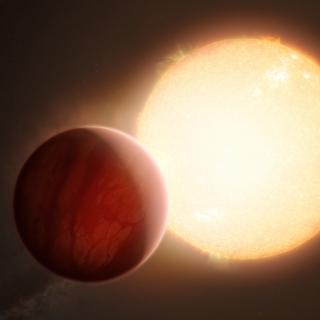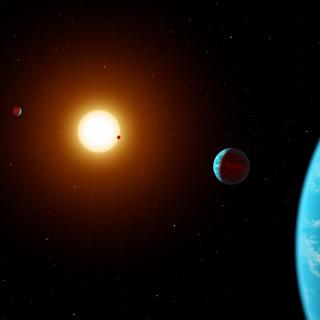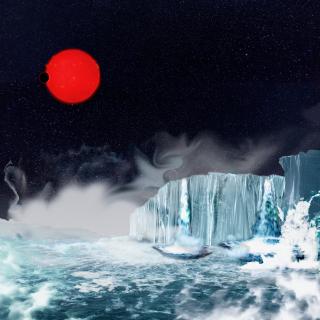Grants related:
General
The search for life in the universe has been driven by recent discoveries of planets around other stars (known as exoplanets), becoming one of the most active fields in modern astrophysics. The growing number of new exoplanets discovered in recent years and the recent advance on the study of their atmospheres are not only providing new valuable information about its physical properties, but also allowing to constrain the properties of the Solar system's planets within a more global context. The field is approaching to the important discovery of the first potentially habitable planets and encouraging more detailed studies of them. With the launching of upcoming related satellites like JWST, CHEOPS, TESS, ARIEL and PLATO, the exoplanets field faces a bright future.
It is for this reason that this field is aid of, and at the same time promotes, the development of increasingly sensitive and stable instrumentation for both, ground-based telescopes and space missions. Our group is particularly prepared for these two fronts. On the one hand, during the last years we have developed observational and reduction techniques of exoplanet transits data for the ORM telescopes, ours being one of the most productive groups in the exploitation of GTC. On the other hand, all ESA space missions (present and future) related to exoplanets have one or more components of the project as CoIs. Within the frame of this project, we intend that IAC researchers maintain an advantageous position regarding the operation of OSIRIS and CanariCam, first light
GTC's instruments, and participate in the construction, commissioning and operation of new instruments such as the high resolution optical spectrograph HORUS at GTC. The exploitation of the photometry and spectroscopy of transits with LIRIS at WHT is also one of our principal interests, especially in preparation for the installation in 2015 of EMIR on the GTC .
To summarize, the project "Exoplanets and Astrobiology" will focus on these four action lines:
1) The characterization of atmospheric and physical properties of exoplanets (GTC, WHT, ARIEL, HARPSN, CARMENES, ESPRESSO, etc. ..)
2) The search and confirmation of exoplanets by transits techniques (CoRoT, Kepler, K2, CHEOPS, XO, LCOGT, W FC, DISH, etc. ..)
3) The search and confirmation of exoplanet by radial velocity techniques (HARPSN, HORUS, LCOGT, SONG, CARMENES)
4) Astrobiology
Members
Results
- Detection of He in the atmosphere of an exoplanet from the ground, published in Science
- Detection of a super-earth around Barnard star, published in Nature
- Detection of the first TESS planets, with several papers of high relevance
- Discovery of Na and Halpha features in the spectrum of KELT-20b with TNG
- Publication of the Handbook of Exoplanets, the most extensive work of reference in the field of exoplanets. The Handbook was edited by members of our group, and includes contributions by about 300 experts worldwide, including 12 members of IAC.
Scientific activity
Related publications
-
TOI-733 b: A planet in the small-planet radius valley orbiting a Sun-like star
We report the discovery of a hot (T eq ≈ 1055 K) planet in the small-planet radius valley that transits the Sun-like star TOI-733. It was discovered as part of the KESPRINT follow-up program of TESS planets carried out with the HARPS spectrograph. TESS photometry from sectors 9 and 36 yields an orbital period of {P {{orb}}} = 4.884765 - 2.4e - 5 +
Georgieva, Iskra Y. et al.Advertised on:
62023 -
VaTEST. II. Statistical Validation of 11 TESS-detected Exoplanets Orbiting K-type Stars
NASA's Transiting Exoplanet Survey Satellite (TESS) is an all-sky survey mission designed to find transiting exoplanets orbiting nearby bright stars. It has identified more than 329 transiting exoplanets, and almost 6000 candidates remain unvalidated. In this manuscript, we discuss the findings from the ongoing Validation of Transiting Exoplanets
Mistry, Priyashkumar et al.Advertised on:
72023 -
TOI-5678b: A 48-day transiting Neptune-mass planet characterized with CHEOPS and HARPS★
Context. A large sample of long-period giant planets has been discovered thanks to long-term radial velocity surveys, but only a few dozen of these planets have a precise radius measurement. Transiting gas giants are crucial targets for the study of atmospheric composition across a wide range of equilibrium temperatures and, more importantly, for
Ulmer-Moll, S. et al.Advertised on:
62023 -
Refined parameters of the HD 22946 planetary system and the true orbital period of planet d★
Context. Multi-planet systems are important sources of information regarding the evolution of planets. However, the long-period planets in these systems often escape detection. These objects in particular may retain more of their primordial characteristics compared to close-in counterparts because of their increased distance from the host star. HD
Garai, Z. et al.Advertised on:
62023 -
TOI-4010: A System of Three Large Short-period Planets with a Massive Long-period Companion
We report the confirmation of three exoplanets transiting TOI-4010 (TIC-352682207), a metal-rich K dwarf observed by the Transiting Exoplanet Survey Satellite in Sectors 24, 25, 52, and 58. We confirm these planets with the High Accuracy Radial velocity Planet Searcher for the Northern Hemisphere radial velocity observations and measure their
Kunimoto, Michelle et al.Advertised on:
72023 -
TESS and CHEOPS discover two warm sub-Neptunes transiting the bright K-dwarf HD 15906
We report the discovery of two warm sub-Neptunes transiting the bright (G = 9.5 mag) K-dwarf HD 15906 (TOI 461, TIC 4646810). This star was observed by the Transiting Exoplanet Survey Satellite (TESS) in sectors 4 and 31, revealing two small transiting planets. The inner planet, HD 15906 b, was detected with an unambiguous period but the outer
Tuson, A. et al.Advertised on:
82023 -
Two warm Neptunes transiting HIP 9618 revealed by TESS and Cheops
HIP 9618 (HD 12572, TOI-1471, TIC 306263608) is a bright (G = 9.0 mag) solar analogue. TESS photometry revealed the star to have two candidate planets with radii of 3.9 ± 0.044 R ⊕ (HIP 9618 b) and 3.343 ± 0.039 R ⊕ (HIP 9618 c). While the 20.77291 d period of HIP 9618 b was measured unambiguously, HIP 9618 c showed only two transits separated by a
Osborn, H. P. et al.Advertised on:
82023 -
The CARMENES search for exoplanets around M dwarfs. Line-by-line sensitivity to activity in M dwarfs
Context. Radial velocities (RVs) measured from high-resolution stellar spectra are routinely used to detect and characterise orbiting exoplanet companions. The different lines present in stellar spectra are created by several species, which are non-uniformly affected by stellar variability features such as spots or faculae. Stellar variability
Lafarga, M. et al.Advertised on:
62023 -
Detection of Carbon Monoxide's 4.6 Micron Fundamental Band Structure in WASP-39b's Atmosphere with JWST NIRSpec G395H
Carbon monoxide (CO) is predicted to be the dominant carbon-bearing molecule in giant planet atmospheres and, along with water, is important for discerning the oxygen and therefore carbon-to-oxygen ratio of these planets. The fundamental absorption mode of CO has a broad, double-branched structure composed of many individual absorption lines from 4
Grant, David et al.Advertised on:
52023 -
Discovery of a substellar companion in the TESS light curve of the δ Scuti/γ Doradus hybrid pulsator HD 31221
Context. Close-in, sub-stellar companions to δ Scuti type stars present a highly suitable testbed for examining how planetary-mass objects can influence stellar pulsations. Aims: We aim to constrain the mass of HD 31221 b, probe its atmosphere, and demonstrate how it affects the pulsational pattern of its host, HD 31221. Methods: We made use of the
Kálmán, Sz. et al.Advertised on:
52023 -
Characterisation of the upper atmospheres of HAT-P-32 b, WASP-69 b, GJ 1214 b, and WASP-76 b through their He I triplet absorption
Characterisation of atmospheres undergoing photo-evaporation is key to understanding the formation, evolution, and diversity of planets. However, only a few upper atmospheres that experience this kind of hydrodynamic escape have been characterised. Our aim is to characterise the upper atmospheres of the hot Jupiters HAT-P-32b and WASP-69 b, the
Lampón, M. et al.Advertised on:
52023 -
A temperate Earth-sized planet with tidal heating transiting an M6 star
Temperate Earth-sized exoplanets around late-M dwarfs offer a rare opportunity to explore under which conditions planets can develop hospitable climate conditions. The small stellar radius amplifies the atmospheric transit signature, making even compact secondary atmospheres dominated by N 2 or CO 2 amenable to characterization with existing
Peterson, Merrin S. et al.Advertised on:
52023 -
Photochemically produced SO<SUB>2</SUB> in the atmosphere of WASP-39b
Photochemistry is a fundamental process of planetary atmospheres that regulates the atmospheric composition and stability 1. However, no unambiguous photochemical products have been detected in exoplanet atmospheres so far. Recent observations from the JWST Transiting Exoplanet Community Early Release Science Program 2,3 found a spectral absorption
Tsai, Shang-Min et al.Advertised on:
52023 -
The CARMENES search for exoplanets around M dwarfs. A deep transfer learning method to determine T<SUB>eff</SUB> and [M/H] of target stars
The large amounts of astrophysical data being provided by existing and future instrumentation require efficient and fast analysis tools. Transfer learning is a new technique promising higher accuracy in the derived data products, with information from one domain being transferred to improve the accuracy of a neural network model in another domain
Bello-García, A. et al.Advertised on:
52023 -
Detection of a high-velocity sodium feature on the ultra-hot Jupiter WASP-121 b
Context. Ultra-hot Jupiters, with their high equilibrium temperatures and resolved spectral lines, have emerged as a perfect testbed for new analysis techniques in the study of exoplanet atmospheres. In particular, the resolved sodium doublet as a resonant line has proven a powerful indicator to probe the atmospheric structure over a wide pressure
Seidel, J. V. et al.Advertised on:
52023 -
Planetary system around LTT 1445A unveiled by ESPRESSO: Multiple planets in a triple M-dwarf system
We present radial velocity follow-up obtained with ESPRESSO of the M-type star LTT 1445A (TOI-455), for which a transiting planet b with an orbital period of 5.4 days was detected by TESS. We report the discovery of a second transiting planet (LTT 1445A c) and a third non-transiting candidate planet (LTT 1445A d) with orbital periods of 3.12 and 24
Lavie, B. et al.Advertised on:
52023 -
A new dynamical modeling of the WASP-47 system with CHEOPS observations
Among the hundreds of known hot Jupiters (HJs), only five have been found to have companions on short-period orbits. Within this rare class of multiple planetary systems, the architecture of WASP-47 is unique, hosting an HJ (planet-b) with both an inner and an outer sub-Neptunian mass companion (-e and -d, respectively) as well as an additional non
Nascimbeni, V. et al.Advertised on:
52023 -
Three Long-period Transiting Giant Planets from TESS
We report the discovery and orbital characterization of three new transiting warm giant planets. These systems were initially identified as presenting single-transit events in the light curves generated from the full-frame images of the Transiting Exoplanet Survey Satellite. Follow-up radial velocity measurements and additional light curves were
Brahm, Rafael et al.Advertised on:
62023 -
TOI-1442 b and TOI-2445 b: Two potentially rocky ultra-short period planets around M dwarfs
Context. Exoplanets with orbital periods of less than one day are known as ultra-short period (USP) planets. They are relatively rare products of planetary formation and evolution processes, but especially favourable for characterisation with current planet detection methods. At the time of writing, 125 USP planets have already been confirmed. Aims
Morello, G. et al.Advertised on:
52023 -
Another shipment of six short-period giant planets from TESS
We present the discovery and characterization of six short-period, transiting giant planets from NASA's Transiting Exoplanet Survey Satellite (TESS) -- TOI-1811 (TIC 376524552), TOI-2025 (TIC 394050135), TOI-2145 (TIC 88992642), TOI-2152 (TIC 395393265), TOI-2154 (TIC 428787891), and TOI-2497 (TIC 97568467). All six planets orbit bright host stars
Rodriguez, Joseph E. et al.Advertised on:
52023





